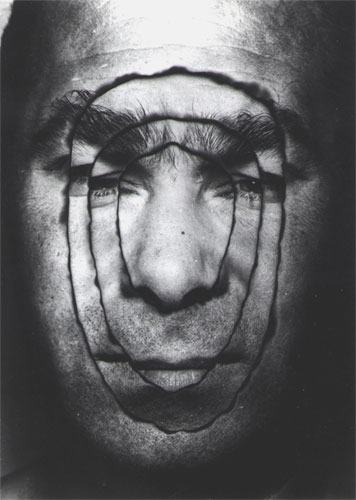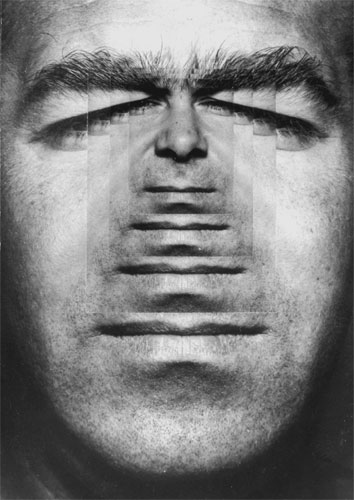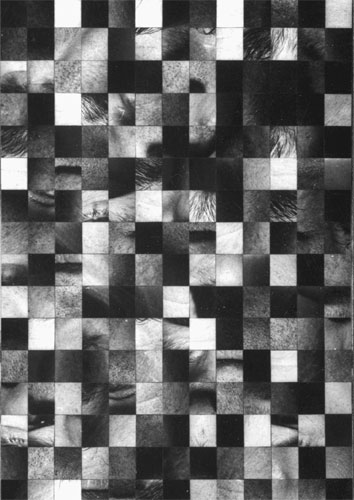


Janusz Bąkowski - Explorations in Photography
Zbigniew Dłubak about Janusz Bąkowski’s art (1976)
Bąkowski’s achievements, though still not known well enough and still not really included in the history of Polish art, seem especially interesting and original against the background of the art of the 70s. His works, coming into being since the break of this decade, concentrate around the systematically and consistently probed artistic problems.
Bąkowski almost in the beginning of his career worked out his own original method whose consequences can be seen at first glance. From the point of view of general artistic taxonomy his method resembles positive photomontage of cutting and glueing. The closest that Bąkowski came to using this method was in his works from the end of the 60s, like Murzyn [Negro, 1968] or Usta [Lips, 1968], although neither of the two could be considered the classic example of photomontage. Bąkowski’s method began with a complex work of many elements, entitled Marek [Mark, 1968-1970].
In this work, which is extremely important for his later explorations, we can see the difference between his method and classic photomontage. In the case of photomontage the aim of montage and manipulation is to create a metaphorical image, i.e. a kind of a super-image, created from the interferences of meanings and contents of fragments of images adjacent to one another in the montage sequence, while Bąkowski’s method serves to divide the image into precisely measured fragments and to put them together again, creating a new image structure. The difference between classic photomontage and the images created by his method results not only from different intentions and aims but most of all from the way of their reception. The photomontage image is addressed to the imagination of the viewer in which it comes into being thanks to the association of the meanings of individual pictures. In Bąkowski’s works the image content reaches the viewer in a different way. Its perception does not demand using the mechanisms of imagination but it is an act of intellectual cognition. The content of the whole image and its individual fragments is legible though not obvious. Their mutual relations are precisely constrained by the given constructional rule, adopted in the given work. The basic value and the message of the work is not, therefore, contained in the contents but in its idea, in the thought that preceded its creation and that accompanied the process of its realization, as well as in the way in which this image structure stimulates the viewer’s reflection and encourages him to make an intellectual effort. Only then the aim it was supposed to fulfill is achieved - when the image is reconstructed in the mind of an intellectually active viewer. Bąkowski was somewhat a scholar, an analyst without emotions who posed problems and equally methodically solved them in his successive works according to almost scientific standards, thanks to his intellectual and technical discipline. Bąkowski’s works are a kind of experiment that serves as the test for each new transformation algorithm conceived by the author. With the changing of this algorithm his explorations deepened and he discovered new and surprising possibilities both in photography and in other branches of art.
It is in this sense that his works belong to the strong (and very diverse in Poland) tendency in the art of the 70’s, based on the conceptual method. Although conceptual, Bąkowski’s works, very laborious and perfectly executed, are historically an important part of this tendency in art. What makes his works different from other examples of media art of this period is that not counting their basic value, they are also intriguing and attractive visually. Conceptual media art was then dominated usually by an extremely raw form, sometimes devoid of visual order and carelessly executed. Its modest form of articulation made intellectual engagement difficult or even discouraged it. Next to Natalia Lach-Lachowicz or Zbigniew Dłubak Bąkowski belonged to those representatives of this tendency who creating important, deeply intellectual and difficult works, gave them an ordered and well thought-out form. It was not a hidden attempt at the aestheticization of the work but rather the manifestation of the wish to make his conceptual idea more vivid and to articulate it clearly. Usually this feature could be found among the works of those artists - to whom our author also belonged - who conducted the most authentic, penetrating and consistent media analyses, combining them with exploration of other spheres of art.
The first phase, as I have already noted, of the evolution of his method is well represented by the series Marek from 1968-1970. The element that undergoes transformations in this case is the portrait of a man’s face in large close-up. Different ways in which this picture is transformed retain the basic legibility of the original portrait - or reduce it. One of the first pictures in the series, Marek II, was made from two identical prints cut into narrow strips - one vertically, the other horizontally. The image was reconstructed to resemble the original by interweaving those strips at right angles. Marek III, another one of those transformed images, was built of four identical prints set one on top of another; in three of them a progressively bigger and bigger hole was burnt out. Piled on on top of one another they created an image resembling the model’s face. The most advanced transformation is Marek V. Here the print was cut into small, rectangular pieces which have been later put together at random, filling the whole surface of the picture. The content of this surface is not legible as a whole any more, though it is 100% identical with the original picture. The lack of any rule organizing the new structure of the elements helped to create an image in the state of complete internal disintegration.
The last of the works from the Marek series heralds the next stage in Bąkowski’s career which will be marked by the new organization of the elements. The image divided into small identical square fragments is put together again according to a mathematically calculated algorithm. One of the most interesting examples of using this method is Rynek Starego Miasta [Old Market Square 1, 1973]. The work consists of three parts: the first presents a fragment of the Old Market from bird’s eye view which is the initial image, transformed later. The second part uses squares measuring 2 by 2 centimetres into which two identical prints were cut. Two identical fragments of the picture in the left upper corner of the first photo have been placed next to each other in the left upper corner of the new picture, two next identical fragments have been then glued to them, and so on, and so forth: the whole surface is filled in such a way, up to the end of the first row, and then in others. The third part, executed according to the same method of setting identical fragments of the picture next to each other, uses fragments of four identical prints of the original picture. Four fragments of the left upper corner have been combined to create a square and placed in the left upper corner of the new image field, four other fragments in the form of a square have been glued to them, and so on, until the surface in the first row and the whole picture is filled. The structure of the images in the second part viewed as a whole retained traces of recognizability of the original image - but not the third part, where fragments of four prints created a structure in which when seen as a whole the content of the original picture cannot be identified, although every one of their hundreds of elements still contains its fragmentary though legible and miniature pictures. The geometry of the shape of a single and multiplied fragment of the original image and the mathematical rule of doubling the same fragments in successive mutations makes them finally lose any similarity to the content of the first picture. In spite of this fact the mathematical order defining the system of this structure makes it an ordered and intruiging whole.
Bąkowski recomposes the initial image. He atomizes and reduces its remnant image content to the edge of legibility. Later he uses this single fragment out of context to create a new image structure in which the fragmentary content of a single element receives a new function and serves to create a new image through the recomposition of the first picture.
Single images and their fragmentary content creating the structure of Bąkowski’s works do not overlap in those structures to create something new. Set next to each other according to geometrical and mathematical rules they rather combine and sum up. It is their sum and not their product that is the condition of the existence of the message intended by the author. Bąkowski’s works have a certain unusual feature though it was not the reason for their creation. Seen once even in passing they remain for long in memory. Their intriguing structure forces the viewer to think about what he sees in those images, how he sees photography and the world in general. They are a kind of an experiment testing new algorithms of transformation. By changing these algorithms, Bąkowski broadened his explorations, discovering new and surprising possibilities both in the sphere of photography and beyond.
Lech Lechowicz



Next exhibition
12.09.2008
Copyright ©2008 Galeria FF ŁDK, Janusz Bąkowski, Lech Lechowicz